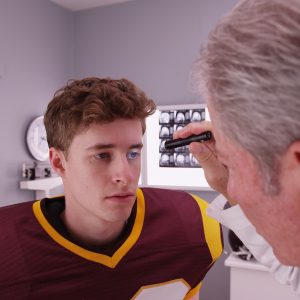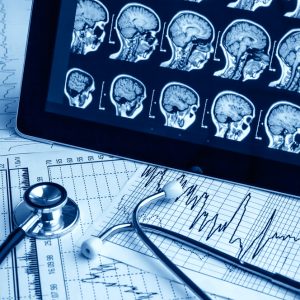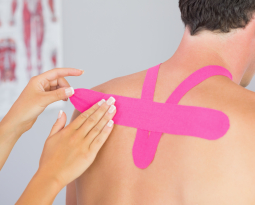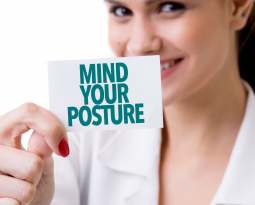
Why Postural Correction Is Important For Patients With Concussion
More and more athletes are presenting with concussions. This has become a public health concern among athletes, their parents, healthcare providers, and is more prevalent in the media.
Understanding concussions and how they impact your patients is fundamental for healthcare professionals.
Understanding concussions and how they impact your patients is fundamental for healthcare professionals.
Post Concussion Syndrome
Postural Neurology is an important factor for the co-management of post-concussion patients. Post-concussion syndrome can have a large impact on the Posture System, especially interfering with your patient’s balance.
Many patients will also have over stimulation of their central nervous system, resulting in headaches, eye sensitivity, and dizziness during the post-concussion rehabilitation phase.
Discover the role that Postural Neurology plays in helping your patients overcome post-concussion symptoms.
Incidence of Concussion
Concussion is defined as a trauma-induced alteration in mental status that may involve a loss of consciousness. In the United States there is an estimated 300,000 sports-related concussions that occur annually. Among individuals 15 to 24 years of age, sports are second only to motor vehicle crashes as the leading cause of concussions (Marar et al., 2012).
Many concussions go undiagnosed because athletes often fail to report concussive symptoms or are not accurately identified as having concussive symptoms.
This may be because of one or two reasons:
- Athletes want to continue playing sports, so they ignore the symptoms or downplay the severity of the symptoms
- Or because the healthcare professional is not trained to know what to look for, and is missing indications of post-concussion syndrome.
Recent research shows that young athletes are more susceptible to concussions than older athletes. Because of the ongoing neurocognitive development that occurs throughout adolescence, concussions can have severe acute and long-term complications in young athletes.
Player to player high contact sports such as football, ice hockey, and lacrosse cause a majority of concussions. The overall rate of concussion is higher in competition than in practice, and girls have higher concussion rates than boys in gender-comparable sports. The majority of student-athletes missed more than 1 week of sports activity as a result of their concussion (Marar et al., 2012).
Symptoms Associated with Concussion
The most commonly reported concussion symptom is a headache, which affects 94.2% of people, followed by dizziness in 75.6% of patients, and concentration difficulty in 54.8% of patients.
Other symptoms included confusion for 45.0% of people, light sensitivity for 36.0% of patients, and nausea 31.4% of time (Marar et al., 2012).
- Headache

- Dizziness
- Concentration Difficulty
- Confusion
- Light Sensitivity
- Nausea
Reports of dizziness and imbalance are prevalent in individuals who have had a concussion. From 23% up to 81% of patients report dizziness in the first days post concussion. The prevalence of persistent dizziness after a concussion varies greatly from 16 to 32.5%. Persistent symptoms may last from three months up to five years (Alsalaheen et al., 2013).
Persistent balance problems have also been reported three weeks post concussion. Patients with dizziness and imbalance post concussion may exhibit impairments of Eye-Head Coordination, Standing Static Balance and Ambulation analyses.
Acute and persistent balance deficits are likely the result of not using information from the vestibular and visual systems effectively. Neurocognitive deficits are more difficult to identify in the acute stages of concussion.
Acute and persistent balance deficits are likely the result of not using information from the vestibular and visual systems effectively.
Post-concussion syndrome athletes also demonstrated postural stability deficits most likely linked to a sensory interaction problem during the immediate post-injury period. The initial 2 days after concussion appeared to be problematic for most concussed athletes (Alsalaheen et al., 2013).
Posture Analysis for Post Concussion Patients
Postural stability and neuropsychological testing are gradually becoming integral parts of post-concussion assessment in athletes. From a Postural Neurology perspective, these are important areas to focus on for analysis and rehabilitation purposes.
The use of neuropsychological and postural stability testing for the management of sports-related concussions is gradually becoming more commonplace among sports medicine practitioners. Recent research suggests that the use of a comprehensive approach may assist the athletic trainer and team physician in identifying signs of a concussion not easily detected during a routine clinical examination.
Postural stability testing provides a useful tool for objectively assessing the motor domain of neurologic functioning, and should be considered a reliable and valid adjunct to the assessment of athletes suffering from concussion (Guskiewicz et al., 2001). 
Having a baseline measurement of the athlete’s postural stability pre-injury would be ideal. If they are hurt, they can then compare their motor neuropsychologic function pre and post injury.
From a clinical application perspective, it would be beneficial to do pre-scans of athletes in their pre-season training for comparison when under stress or if suffering from an injury.
- Pre-season scans of all athletes before any competition or injury.
- Upon stress or injury, include postural stability testing alongside routine clinical examinations.
- Compare measurements against athletes’ pre-scans and other medical history.
Posture Rehabilitation for Post Concussion Patients
For Postural Neurology rehabilitation of patients suffering from post-concussion syndrome, vestibular rehabilitation is a key component to the management of dizziness and balance disorders resulting from vestibular system dysfunction, either peripherally or centrally.
Vestibular rehabilitation is a key component to the management of dizziness and balance disorders resulting from vestibular system dysfunction.
Alsalaheen (2013) evaluated the most commonly prescribed exercises for post-concussion rehabilitation. It was determined that Eye-Head Coordination exercises were the most commonly prescribed exercise type in 95% of research participants, followed by Standing Static balance exercises in 88% of participants, and Ambulation exercises in 76% of participants.
In addition to these exercises, it also recommended in many cases to perform spinal alignment exercises, to have patients wear dim glasses to reduce incoming light, and to perform vestibular training.
- Eye-Head Coordination Exercises
- Standing Static Balance Exercises
- Ambulation Exercises
- Spinal Alignment Exercises
- Wearing Dim Glasses
- Perform Vestibular Training
All rehabilitation recommendations should be case-specific, and should be based upon the patient’s individual needs. Rehabilitation of post-concussion symptoms should begin after the patient has an adequate amount of rest. If rehabilitation is started too soon, you may drive a delicate patient past the point of neural fatigue very quickly, resulting in a headache or further discomfort.
Posture Rehabilitation Recommendations
Postural Neurology is a brain based approach to help your patients achieve better postural balance and long-term postural correction results. Post-concussion patients may be highly compromised if not properly assessed and if not given the proper rehabilitation recommendations.
Working with post-concussion patients is rewarding when you know best practices and how to approach their case presentation. Postural Neurology is an important piece to the concussion puzzle.
References:
Alsalaheen, B. A., Whitney, S. L., Mucha, A., Morris, L. O., Furman, J. M., & Sparto, P. J. (2013). Exercise prescription patterns in patients treated with vestibular rehabilitation after concussion. Physiotherapy Research International, 18(2), 100-108.
Guskiewicz, K. M. (2001). Postural stability assessment following concussion: one piece of the puzzle. Clinical Journal of Sport Medicine, 11(3), 182-189.
Guskiewicz, K. M., Ross, S. E., & Marshall, S. W. (2001). Postural stability and neuropsychological deficits after concussion in collegiate athletes. Journal of athletic training, 36(3), 263.
Marar, M., McIlvain, N. M., Fields, S. K., & Comstock, R. D. (2012). Epidemiology of concussions among United States high school athletes in 20 sports. The American journal of sports medicine, 40(4), 747-755.













